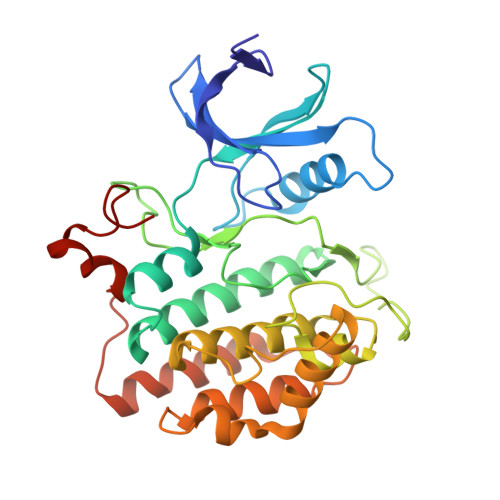Overcoming Fungal Echinocandin Resistance through Inhibition of the Non-essential Stress Kinase Yck2.
Caplan, T., Lorente-Macias, A., Stogios, P.J., Evdokimova, E., Hyde, S., Wellington, M.A., Liston, S., Iyer, K.R., Puumala, E., Shekhar-Guturja, T., Robbins, N., Savchenko, A., Krysan, D.J., Whitesell, L., Zuercher, W.J., Cowen, L.E.(2020) Cell Chem Biol 27: 269-282.e5
- PubMed: 31924499
- DOI: https://doi.org/10.1016/j.chembiol.2019.12.008
- Primary Citation of Related Structures:
6U69, 6U6A - PubMed Abstract:
New strategies are urgently needed to counter the threat to human health posed by drug-resistant fungi. To explore an as-yet unexploited target space for antifungals, we screened a library of protein kinase inhibitors for the ability to reverse resistance of the most common human fungal pathogen, Candida albicans, to caspofungin, a widely used antifungal. This screen identified multiple 2,3-aryl-pyrazolopyridine scaffold compounds capable of restoring caspofungin sensitivity. Using chemical genomic, biochemical, and structural approaches, we established the target for our most potent compound as Yck2, a casein kinase 1 family member. Combination of this compound with caspofungin eradicated drug-resistant C. albicans infection while sparing co-cultured human cells. In mice, genetic depletion of YCK2 caused an ∼3-log 10 decline in fungal burden in a model of systemic caspofungin-resistant C. albicans infection. Structural insights and our tool compound's profile in culture support targeting the Yck2 kinase function as a broadly active antifungal strategy.
- Department of Molecular Genetics, University of Toronto, Toronto, ON M5G 1M1, Canada.
Organizational Affiliation:


















